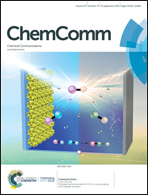Hydroxyapatite nanowires rich in [Ca–O–P] sites for ethanol direct coupling showing high C6–12 alcohol yield†
Abstract
Herein, we have shown that the [Ca–O–P] sites exposed on hydroxyapatite are clearly responsible for C–C formation in ethanol direct-coupling, and their high density accelerates the C–C coupling rate and boosts C6–12 alcohol production. Notably, nanowire-like hydroxyapatite exhibited 30.4% selectivity to n-butanol and 63.9% selectivity to C6–12OH at a conversion of 45.7% at 325 °C, and thereby close to 30% yield of C6–12OH, which is greatly higher than that using the state-of-the-art catalysts (6%).
![Graphical abstract: Hydroxyapatite nanowires rich in [Ca–O–P] sites for ethanol direct coupling showing high C6–12 alcohol yield](/en/Image/Get?imageInfo.ImageType=GA&imageInfo.ImageIdentifier.ManuscriptID=C9CC05454E&imageInfo.ImageIdentifier.Year=2019)


 Please wait while we load your content...
Please wait while we load your content...